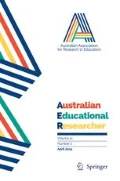Abstract
This paper examines the approaches of cultural and religious inclusion at one small state-funded primary school situated in suburban Australia. The school community is experiencing high levels of racialised, gendered and religious conflict. Through case study data from leaders and teachers, we illustrate the potential and limitations of these approaches and consider their location within the notions of secularity and Christian privilege that characterise Australia’s public education system. The paper is situated within the context of current anxieties around social conflict and unrest especially in relation to religious racism or Islamophobia and amid calls for the introduction of a multi-faith education in Australian public schools. Against this backdrop, we highlight key tensions and difficulties confronting schools in their efforts to be inclusive towards creating a climate of social cohesion.
Similar content being viewed by others
References
Aronson, B., Amatullah, T., & Laughter, J. (2016). Culturally relevant education: Extending the conversation to religious diversity. Multicultural Perspectives,18(3), 140–149.
Asad, T. (2003). Formations of the secular: Christianity, Islam, Modernity. Stanford, CA: Stanford University Press.
Asad, T. (2009). Free speech, blasphemy and secular criticism. In T. Asad, W. Brown, J. Butler, & S. Mahmood (Eds.), Is critique secular? Blasphemy, injury and free speech (pp. 20–63). Berkeley: University of California Press.
Boon, H. J., & Maxwell, B. (2016). Ethics Education in Australian Preservice Teacher Programs: A Hidden Imperative? Australian Journal of Teacher Education, 41(5).
Bouma, G., & Halafoff, A. (2009). Multifaith education and social inclusion in Australia. Journal of Religious Education,57(3), 17–25.
Brown, W. (2009). Introduction. In T. Asad, W. Brown, J. Butler, & S. Mahmood (Eds.), Is critique secular? Blasphemy, injury and free speech (pp. 1–20). Berkeley: University of California Press.
Byrne, C. J. (2014). Religion in secular education: what in heaven’s name, are we teaching our children?. Leiden: Brill.
Ellsworth, E. (1992). Why doesn’t this feel empowering? Working through the repressive myths of critical pedagogy. In C. Luke & J. Gore (Eds.), Feminisms and critical pedagogy (pp. 90–119). London: Routledge.
Figueroa, P. (2000). Citizenship education for a plural society. In A. Osler (Ed.), Citizenship and democracy in schools: Diversity, identity, equality (pp. 47–62). Stoke on Trent: Trentham Books.
Fleras, A. (2009). The politics of multiculturalism. New York: Palgrave Macmillan.
Fraser, N. (1997). Justice interruptus: Critical reflections on the ‘postsocialist’ condition. New York: Routledge.
Garica, K. (2002). Swimming against the mainstream: Examining cultural assumptions in the classroom. In L. Darling-Hammond, J. French, & P. Garcia Lopez (Eds.), Learning to teach for social justice (pp. 22–29). New York: Teachers College Press.
Gearon, L. (2013). The counter terrorist classroom: Religion, education, and security. Religious Education,108(2), 129–147.
Ho, C. (2011). Respecting the presence of others: School micropublics and everyday multiculturalism. Journal of Intercultural Studies,32(6), 603–619.
Humphrey, M. (2007). Culturalising the abject: Islam, law and moral panic in the west. Australian Journal of Social Issues,42(1), 9–25.
Jackson, R. (2004). Studying religious diversity in public education: An interpretive approach to religious and intercultural understanding. Religion & Education,31(2), 1–20.
Jackson, R., & Everington, J. (2016). Teaching inclusive religious education impartially: an English perspective. British Journal of Religious Education,39(1), 7–24.
James, J. H., Schweber, S., Kunzman, R., Barton, K. C., & Logan, K. (2015). Religion in the classroom: Dilemmas for democratic education. New York: Routledge.
Keddie, A. (2012a). Australian multicultural policy: social cohesion through a political conception of autonomy. Journal of Sociology,50(4), 408–421.
Keddie, A. (2012b). Educating for diversity and social justice. New York: Routledge.
Keddie, A. (2017). Supporting and educating young Muslim women: Stories from Australia and the UK. London: Routledge.
Mansouri, F., & Marotta, V. (2012). Muslims in the West: Challenges of belonging. Melbourne: Melbourne University Press.
Mansouri, F., & Wood, S. (2012). Identity, education and belonging: Arab and Muslim youth in contemporary Australia. Melbourne: Melbourne University Press.
Markus, A. (2016). Mapping social cohesion: The Scanlon Foundation surveys 2016. Caulfield East: Monash University.
Mythen, G., & Walklate, S. (2008). Terrorism, risk and international security: The perils of asking ‘what if?’. Security Dialogue,39(2–3), 221–242.
NSW Government. (2018). Legal Issues Bulletin. https://education.nsw.gov.au/about-us/rights-and-accountability/media/documents/public-legal-issues-bulletins/LIB-57-Legal-obligations-of-schools-responding-to-a-student-staff-parent-or-social-and-extremist-behaviour.pdf. Accessed Mar 2018.
Poynting, S. & Noble, G. (2004). Living with racism: the experience and reporting by Arab and Muslim Australians of discrimination, abuse and violence since 11 September 2001. Report to the Human Rights and Equal Opportunities Commission, Centre for Cultural Research. Sydney: Australian Human Rights Commission.
Rowe, E. (2017) Religion in Australian Schools: An historical and contemporary debate, The Conversation. https://theconversation.com/religion-in-australian-schools-an-historical-and-contemporary-debate-82439. Accessed June 2018.
Sleeter, C. (2005). Un-standardizing curriculum. New York: Teachers’ College Press.
VCAA. (no date). Ethical Capability; Rationale and Aims. http://victoriancurriculum.vcaa.vic.edu.au/ethical-capability/introduction/rationale-and-aims
Victoria State Government. (2017). Special religious instruction. http://www.education.vic.gov.au/school/principals/spag/curriculum/Pages/sri.aspx#link4. Accessed Mar 2018.
Victorian Government. (2006). Education and Training Reform Act, Act No. 24/2006. http://www.legislation.vic.gov.au/Domino/Web_Notes/LDMS/PubStatbook.nsf/51dea49770555ea6ca256da4001b90cd/575C47EA02890DA4CA25717000217213/$FILE/06-024a.pdf. Accessed Mar 2018.
Youdell, D. (2003). Identity traps or how black students fail: The interactions between biographical, sub-cultural and learner identities. British Journal of Sociology of Education,24(1), 3–20.
Author information
Authors and Affiliations
Corresponding author
Rights and permissions
About this article
Cite this article
Keddie, A., Wilkinson, J., Howie, L. et al. ‘…we don’t bring religion into school’: issues of religious inclusion and social cohesion. Aust. Educ. Res. 46, 1–15 (2019). https://doi.org/10.1007/s13384-018-0289-4
Received:
Accepted:
Published:
Issue Date:
DOI: https://doi.org/10.1007/s13384-018-0289-4




